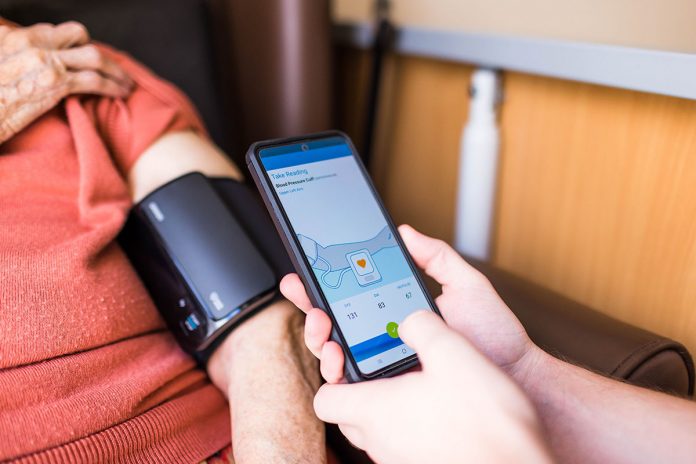Elina Naydenova, CEO & Co-Founder of Feebris, argues that patient monitoring has reached a tipping point
An unsustainable future
Patient monitoring across the UK is in crisis, with our expanding, ageing population and undersupply of clinicians and hospital space, there’s a clear need for a novel and creative approach to the delivery of healthcare services.
Across primary and secondary care in England, there are currently 2.8 doctors per 1,000 people – a shortage of nearly 50,000 and almost 7 million globally. By 2050, one in four people in the UK will be 65 years and over; an increase from one in five in 2019.
“If we don’t change the way we deliver healthcare, it will be impossible to meet patient needs.”
NHS waiting lists could grow to over 14 million in England next year, according to the Institute for Fiscal Studies. Chronic stress, fatigue and burnout increases the risk of mistakes and is driving talented clinicians out of the workforce.
Breaking down barriers
The paradigm of patient monitoring is shifting.
Patient numbers are only increasing and the barriers to equitable, quality healthcare must be removed. It’s estimated that £165 billion could be saved by reducing hospitalisations from avoidable respiratory episodes, and nearly a quarter of all emergency admissions in the UK could be avoided with better community care.
Accurate, accessible and efficient patient monitoring can significantly reduce admissions and length of stays. Since lockdowns began, we’ve seen social care workers facilitating remote ward rounds and capturing clinical information essential for remote diagnosis and treatment. While some of these moves away from traditional methods are temporary, this represents an opportunity to adopt sustainable improvements.
Enable and upskill the existing workforce
Feebris provides remote patient monitoring technology that allows non-clinical workers, carers or health assistants to capture clinical-quality measurements and triage patients in under seven minutes. Advanced AI algorithms evaluate individual measurements, providing real-time feedback to the carer to ensure no noise/error is introduced into the data and ensure the readings provided to clinicians are highly accurate. All wrapped into an intuitive, hardware-agnostic, offline-capable mobile application.
The algorithms detect disease markers and fuse them into a prediction of health risks, equipping community caregivers with expert knowledge and guidance. Use of Feebris in care homes in North East London has been associated with a 700% reduction in false alarms and avoidable urgent care escalations, freeing up clinicians to be where they are most needed. The project, in partnership with Barking and Dagenham, Havering and Redbridge University Hospitals (BHR CCG), also recorded an 85% increase in the proactive and preventative management of health issues, helping carers and other professionals to take on new roles and responsibilities.
“Feebris has helped impact patient care and reduce A&E admissions. It has provided pertinent and important clinical data to inform clinical management.” – GP (BHR, London)
All algorithms are rigorously clinically validated – errors in remote patient monitoring data could mean critical symptoms or signs of deterioration are missed, costing millions in operational waste and avoidable hospitalisation, so any scalable, reliable AI solution must be ethical and high quality by design. AI should work as a physician’s assistive tool to aid human decision-making, rather than replace it and must earn the appropriate level of trust and confidence of those using it. With Feebris, 87% of healthcare workers feel able to make more confident decisions.
Ethical and reliable by design
Even with an empowered community workforce, the most significant barrier to scale remains the reliance on clinicians to trawl through each data point and determine the level of reliability and action to be taken. Remote monitoring, therefore, cannot succeed without clinically-validated AI solutions augmenting processes and filtering large volumes of data to reduce pressure on clinicians and allow them to focus critical decision-making.
In the case of remote monitoring, the more data is captured, the more accurate and reliable the AI becomes for a broader spectrum of people. As the AI delves deeper into disease markers, warning signs can be spotted earlier and with greater accuracy. Training algorithms on patients’ disease progression at scale can then help clinicians recognise patterns, essential for personalisation of treatment and the management of disease.
Mobilising the benefits
As we move towards recovery from this pandemic, we must not leave behind our appetite for innovation and vision for scalable solutions that support equality and improve outcomes.
Clinical leaders from different corners of the UK are striving to redefine healthcare delivery and build better quality and more sustainable delivery models.
In Surrey Heartlands, paediatricians are leading a model for more proactive monitoring of children at high risk of common respiratory viruses such as RSV (respiratory syncytial virus).
In Northumbria NHS Foundation Trust, a long-term partnership led by Jim Mackey is spearheading an integration and digitisation of services, to combat some of the greatest challenges – the most rural Trust with the highest prevelance of long term conditions.
Remote monitoring is already here, and Trusts around the country are seeing immediate improvements. To capture the full potential of this technology, however, as seen in BHR CCG, requires collaboration, commitment and champions for change within the community.
Hand in glove, working together
The benefits of remote monitoring are significant, including decreased costs, earlier diagnoses, reduced hospitalisations and improved remote care. When examined together, these benefits paint a picture of improved quality of life for patients and healthcare workers alike, helping people to give and receive better care.
Health measures can now be captured by anyone, more accurately than ever before, freeing up clinicians to work where they’re needed most. Trust-worthy, validated and reliable tech can save lives, and when combined with cutting edge machine learning algorithms, we can create the change the healthcare system needs.
Please note: This is a commercial profile











